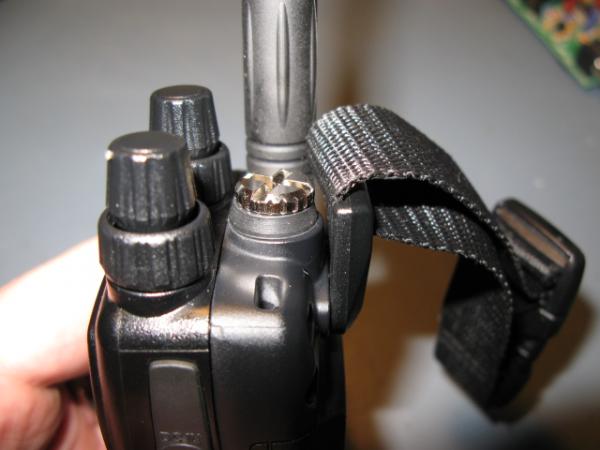I had been trying to get my hands on the new Alinco DJ-G7 HT for some time now, especially since it is currently the only HT that can do 2 meters, 440Mhz, and 1.2GHz and is also full duplex on both VFO's. After numerous attempts to purchase one locally, I saw that AES had them in stock and called them up last week. The UPS guy in the brown truck made my day today  . I only had a little time tonite to play with the radio and snap a few pictures, but I will continue to update this thread with a thorough review of this latest HT.
. I only had a little time tonite to play with the radio and snap a few pictures, but I will continue to update this thread with a thorough review of this latest HT.
Here is a picture of the DJ-G7:
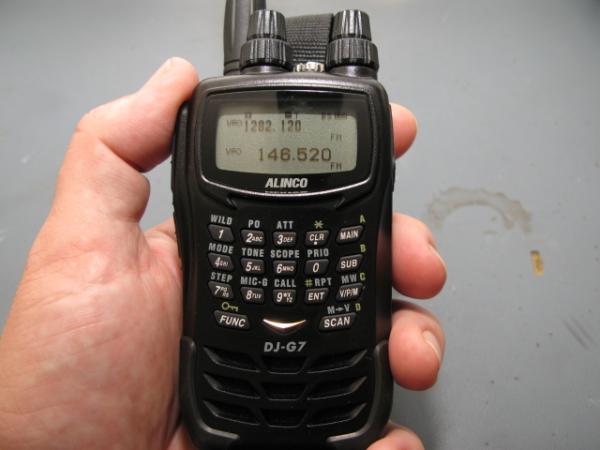
You can tell right away from this picture that the display is very crisp and easy to read, and this picture is taken without the backlight on. It is also very simple and free of clutter. There is something to be said about simplicity on the display. Some radios (like the Yaesu VX-8r) seem to try to display the status of every setting on the screen at once. My first impression of the DJ-G7 was, "Well that's refreshing; A simple display, for a change."
The bottom half of the radio comprises of both the speaker and the mic. I was very pleased that the RX audio quality is quite good. For an HT, it's almost what I would call rich sounding. At the very top, you'll notice that this radio is somewhat unique because it has two sets of double dials. The top dial on each controls the frequency selection and the bottom dial controls the volume. By default, the left set of dials controls the Main VFO and the right set of dials control the SUB VFO. You can choose via settings to swap the dial VFO control if you like. I quickly found that it I kept grabbing the right set of dials first, so I changed that one to correspond to the Main VFO.
Here is a pic of the radio and all of the supplied accessories:
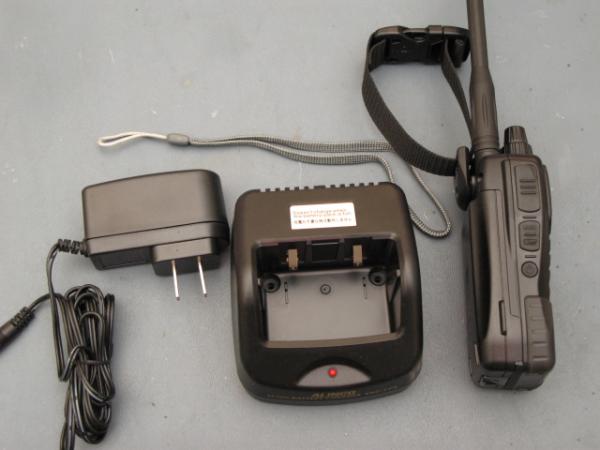
The U.S. version of the radio comes with a 1200mAh Lithium Ion battery, a nylon belt strap (shown attached), an A/C wall wart charger, a wrist strap, and a drop in charger. You can charge the radio by either the A/C wall wart directly or by using the drop in charger. The fact that they include the drop in charger is a testimonial to Alinco's committment to providing exceptional value with their products. Most other brands charge us extra for that accessory, but Alinco includes it!
Here is a picture of the DJ-G7 next to two other familiar HT's for size comparison: the Yaesu VX-2 and VX-8r with the extended battery:
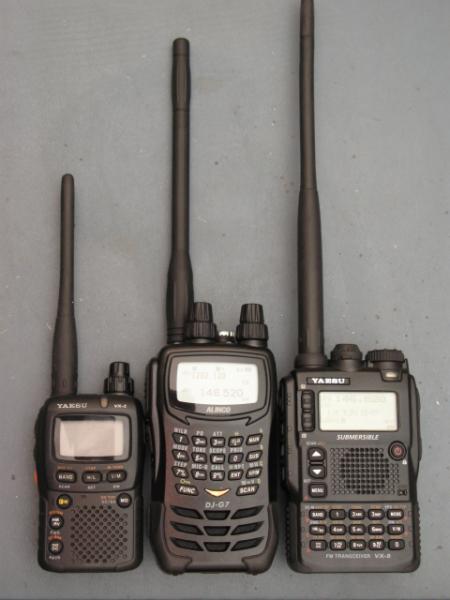
You can see that the Alinco DJ-G7 is about the same width as the Yaesu VX-8r, if not a little narrower.
Here is a sideways shot of all three radios for size comparison:
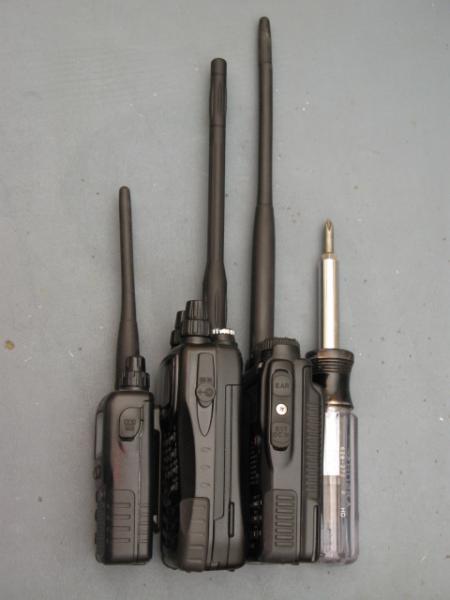
The Alinco is a little fatter than the VX-8r with the extended battery, but not by much. Keep in mind, though that the Yaesu VX-8r with the standard 1100mAh battery will be quite a bit thinner than the Alinco. I think the Alinco has a real good, ergonomic feel in my hands. Even though it's slighly larger, I like the weight, location of the buttons, and the very large PTT button.
This is the top of the radio where optional speaker/mic plugs in. Notice that the speaker/mic plug is covered by a metal screw cap with a rubber seal. The rubber seal is obviously there to keep out moisture an dust. This is another interesting, unique design feature of the DJ-G7.
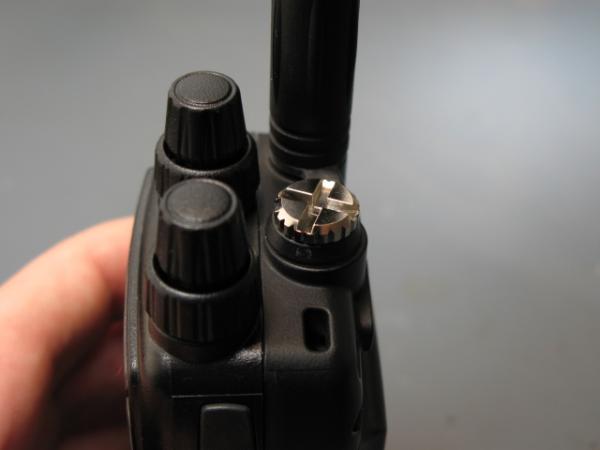
Here is what is underneath that screw cap:
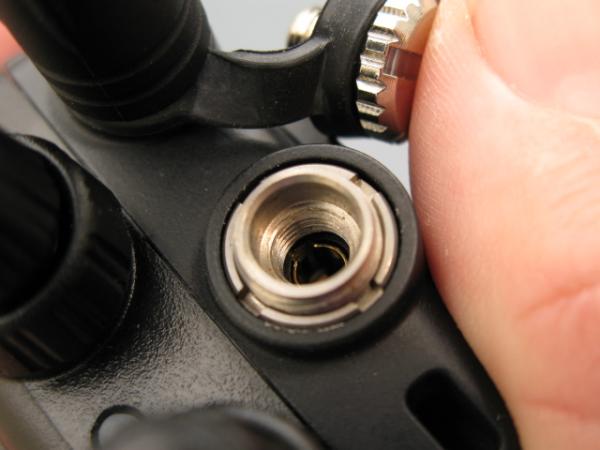
The speaker/mic connection actually screws in using a metal housing. This speaker/mic connector is a little larger than one that you will find on other radios, so it's not exactly standard. Even if it was a standard size, you won't find many connectors that will be able to fit into the radio housing snugly enough due to this radio's screw-in connection. On the upside, this connection is very sturdy and rugged. One of the complaints I always had about my Kenwood TH-F6a was that the speaker/mic adapter was cheap and I had trouble maintaining good contact with the terminals. I don't see that happening with the Alinco's connector. Of course, this means that you are required to purchase Alinco's speaker/mic adapter, as well.
Here is a picture of the only two accessories I included in my initial purchase: ERW-7 PC Interface cable and EDS-10 Mic/Speaker cable.
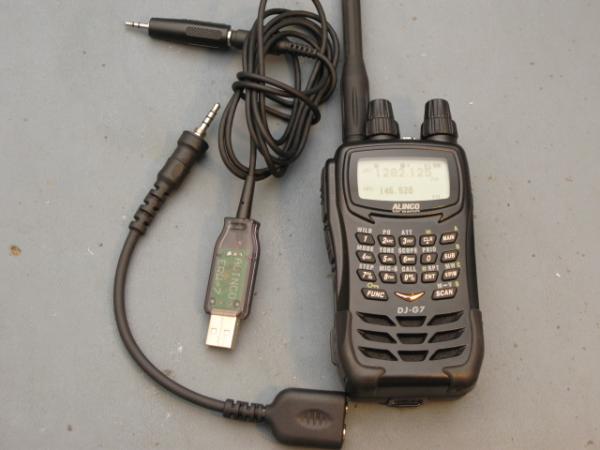
You need both cables to interface to your PC. The ERW-7 USB PC cable is $50, but the EDS-10 Mic/Speaker cable is only $17. You need the EDS-10 adapter anyway, if you ever want to use an external speaker/mic. Using the cable accessories, I was able to update the firmware on the radio using these cables as instructed by the Alinco web site.
More to follow...
Here is a picture of the DJ-G7:

You can tell right away from this picture that the display is very crisp and easy to read, and this picture is taken without the backlight on. It is also very simple and free of clutter. There is something to be said about simplicity on the display. Some radios (like the Yaesu VX-8r) seem to try to display the status of every setting on the screen at once. My first impression of the DJ-G7 was, "Well that's refreshing; A simple display, for a change."
The bottom half of the radio comprises of both the speaker and the mic. I was very pleased that the RX audio quality is quite good. For an HT, it's almost what I would call rich sounding. At the very top, you'll notice that this radio is somewhat unique because it has two sets of double dials. The top dial on each controls the frequency selection and the bottom dial controls the volume. By default, the left set of dials controls the Main VFO and the right set of dials control the SUB VFO. You can choose via settings to swap the dial VFO control if you like. I quickly found that it I kept grabbing the right set of dials first, so I changed that one to correspond to the Main VFO.
Here is a pic of the radio and all of the supplied accessories:

The U.S. version of the radio comes with a 1200mAh Lithium Ion battery, a nylon belt strap (shown attached), an A/C wall wart charger, a wrist strap, and a drop in charger. You can charge the radio by either the A/C wall wart directly or by using the drop in charger. The fact that they include the drop in charger is a testimonial to Alinco's committment to providing exceptional value with their products. Most other brands charge us extra for that accessory, but Alinco includes it!
Here is a picture of the DJ-G7 next to two other familiar HT's for size comparison: the Yaesu VX-2 and VX-8r with the extended battery:

You can see that the Alinco DJ-G7 is about the same width as the Yaesu VX-8r, if not a little narrower.
Here is a sideways shot of all three radios for size comparison:

The Alinco is a little fatter than the VX-8r with the extended battery, but not by much. Keep in mind, though that the Yaesu VX-8r with the standard 1100mAh battery will be quite a bit thinner than the Alinco. I think the Alinco has a real good, ergonomic feel in my hands. Even though it's slighly larger, I like the weight, location of the buttons, and the very large PTT button.
This is the top of the radio where optional speaker/mic plugs in. Notice that the speaker/mic plug is covered by a metal screw cap with a rubber seal. The rubber seal is obviously there to keep out moisture an dust. This is another interesting, unique design feature of the DJ-G7.

Here is what is underneath that screw cap:

The speaker/mic connection actually screws in using a metal housing. This speaker/mic connector is a little larger than one that you will find on other radios, so it's not exactly standard. Even if it was a standard size, you won't find many connectors that will be able to fit into the radio housing snugly enough due to this radio's screw-in connection. On the upside, this connection is very sturdy and rugged. One of the complaints I always had about my Kenwood TH-F6a was that the speaker/mic adapter was cheap and I had trouble maintaining good contact with the terminals. I don't see that happening with the Alinco's connector. Of course, this means that you are required to purchase Alinco's speaker/mic adapter, as well.
Here is a picture of the only two accessories I included in my initial purchase: ERW-7 PC Interface cable and EDS-10 Mic/Speaker cable.

You need both cables to interface to your PC. The ERW-7 USB PC cable is $50, but the EDS-10 Mic/Speaker cable is only $17. You need the EDS-10 adapter anyway, if you ever want to use an external speaker/mic. Using the cable accessories, I was able to update the firmware on the radio using these cables as instructed by the Alinco web site.
More to follow...

